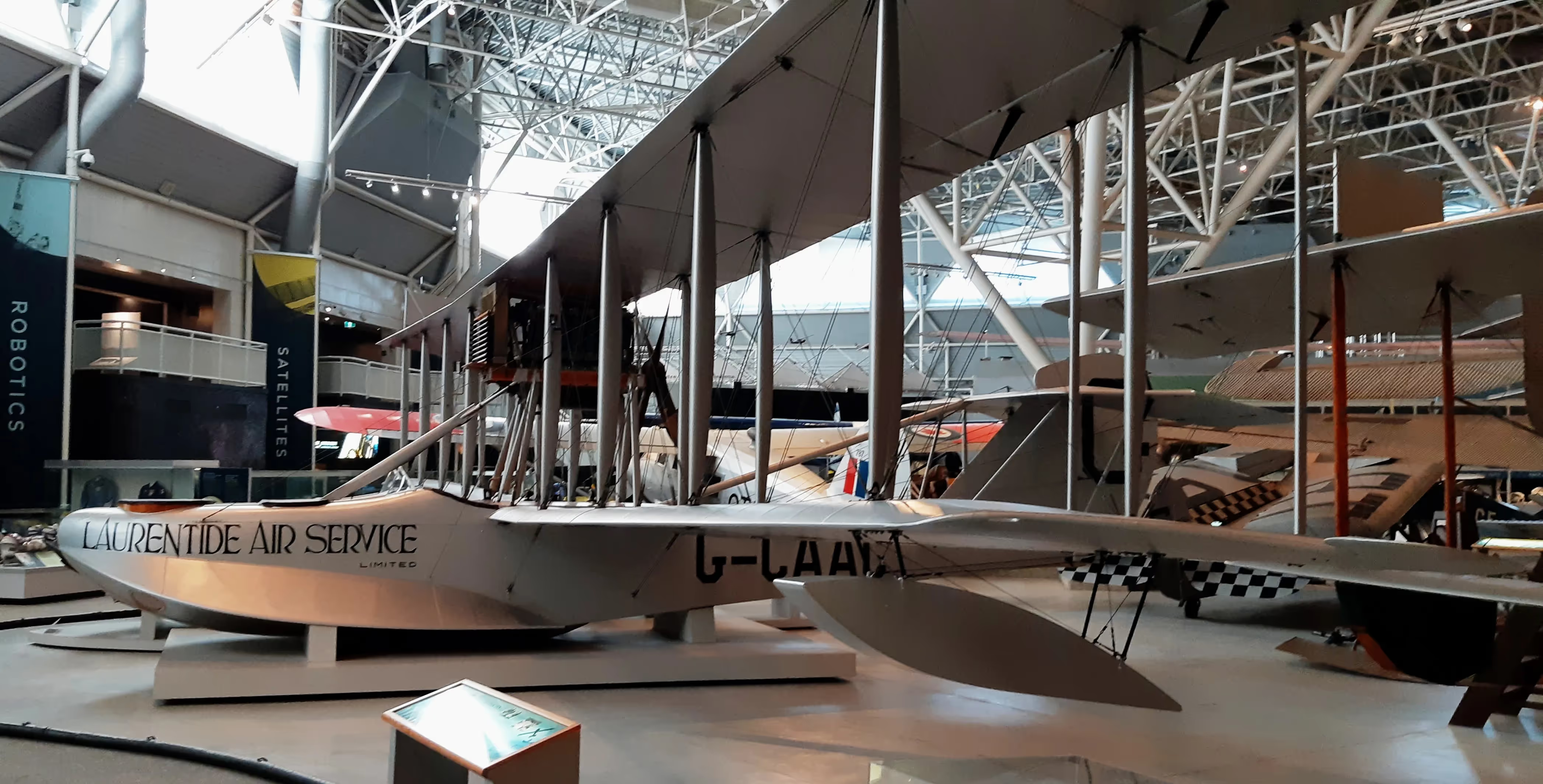Canadian Warplanes 2: Curtiss HS-2L biplane
Curtiss HS-2L biplanes

(Photo courtesy of the Shearwater Aviation Museum)
Curtiss HS-2L (Serial No. 1876) being launched at Dartmouth, Nova Scotia, 1918.
The Curtiss HS-2L was a single-engined patrol flying boat built for the US Navy during the First World War. Large numbers were built from 1917 to 1919, with the type being used to carry out anti-submarine patrols from bases in France from June 1918. It remained in use with the US Navy until 1928, and was also widely used as a civil passenger and utility aircraft. From August 1918, in order to compensate for Canada's lack of patrol aircraft, US Navy HS-2Ls operated from two bases in Nova Scotia. Twelve HS-2Ls were donated to the Canadian Air Board at the end of the war, following the closure of Naval Air Station Halifax. The RCAF acquired 30 HS-2Ls. Many were used in Canada as the first bush plane. One was recovered from a lake in Quebec and is now on display in the Canada Aviation and Space Museum, Ottawa, Ontario.
Three HS-2Ls were modified in Canada by Canadian Vickers with different wings (Clark Y section), and designated HS-3L. (Wikipedia)
Curtiss HS-2L (30) Reg. Nos. G-CYAE-G-CYAH, G-CYBA, G-CYBB, G-CYDR-G-CYDU, G-CYDX, G-CYDY, G-CYEA, G-CYEB, G-CYED, G-CYEF, G-CYEJ-EL, G-CYGA, G-CYGL-GU.

(Library and Archives Canada Photo, MIKAN No. 3643672)
Curtiss HS-2L flying boat G-CYAE of the Canadian Air Board in flight near Roberval, Quebec, c1922.

(Virginia MacKinnon, Richibucto Photo)
Curtis HS-2L, RCAF Reg. No. G-CYDU, visiting Richibucto, New Brunswick, 1920s.

(Virginia MacKinnon, Richibucto Photo)
Curtis HS-2L, RCAF Reg. No. G-CYDU, visiting Richibucto, New Brunswick, 1920s.

(City of Vancouver Archives Photo)
Curtis HS-2L, RCAF Reg. No. G-CYDU, dropping a parachutist, ca 1920.

(Photo courtesy of the Canadian Aviation Preservation Association)
Curtiss HS-2L (Serial No. G-CYAH) on the water.

(RCAF Photo)
Curtiss HS-2L, RCAF (Serial No. G-CAAC) on the water.

(Library and Archives Canada Photo, MIKAN No. 338992)
Curtiss HS-2L, G-CADQ, Ontario Provincial Air Service, 1925.

(Library and Archives Canada Photo, MIKAN No. 3643591)
Curtiss HS-2L, G-CYDS, Canadian Air Board, 1 July 1921.

(Library and Archives Canada Photo, MIKAN No. 3643587)
Curtiss HS-2L, G-CYDT, Canadian Air Board, Victoria Beach, Manitoba, 3 Aug 1921.

(Library and Archives Canada Photo, MIKAN No. 3643588)
Curtiss HS-2L, G-CYDT, Canadian Air Board, Victoria Beach, Manitoba, 3 Aug 1921.

(Library and Archives Canada Photo, MIKAN No. 3580746)
Launching the first HS2L, G-CYBA, at Vancouver, British Columbia, 1920.

(Photo courtesy of the Canadian Aviation Preservation Association)
Curtiss HS-2L, G-CACT, Northern Air Service.

(Photo courtesy of the Canadian Aviation Preservation Association)
Curtiss HS-2L, G-CAAC, Laurentide Air Service, on the water, ca 1920s.









(Author Photos)
Curtiss HS-2L, Laurentide Air Service, hull (Serial No. A1876), (2901-H2, wings of NC652), G-CAAC. This is the only complete HS-2L in the world. It is a reconstruction of G-CAAC La Vigilance, which belonged to Laurentide Air Service Limited, the world’s first bush-flying company. The original La Vigilance was the company’s first aircraft; it was built in 1918 and made the first bush flight in Canada in 1919. That same year, Stuart Graham, Canada’s first professional bush pilot and a member of Canada’s Aviation Hall of Fame, began his civilian career in La Vigilance, and his wife, Madge Graham, became the first Canadian woman to participate in flight when she accompanied him between Nova Scotia and Quebec. On 2 September 1922 La Vigilance crashed into Foss Lake, Quebec, where it remained until 1967, when Donald Campbell of Kapuskasing reported the location of the wreck at the bottom of the lake. The hull, along with metal parts and fittings from the aircraft, was retrieved by the Museum during a salvage operation between 1968 and 1969. The original hull was preserved separately and is displayed next to the reconstructed aircraft, which was built using parts from three different HS-2Ls. Restoration of this HS-2L lasted from 1970 until 1986, making it the largest and longest restoration project the Canada Air & Space Museum has undertaken. (CA&SM)
_(20531911065).avif)
(The Canadian Forest Industries Photo)
One of the large Curtis HS-2l 6-passenger flying boats operated on a weekly service between Toronto and the Muskoka Lakes, a distance of 130 miles, by the Barker Aeroplanes. Limited. Acknowledged to be the most famous airmen of the war. Lt.-Col. W. A. Bishop and Lt.-Col W. G. Barker and their organization became "the recognized aerial experts of the Dominion". July-December 1920.

(Community Archives Photo)
Curtiss HS-2L float plane 'Canadian Maid' owned by Bishop-Barker Aeroplanes Ltd. Photograph taken at Victoria Park in Belleville, Ontario, looking towards Front Street. Part of a photograph album created by the Cornell family of Belleville, Ontario, 1920





